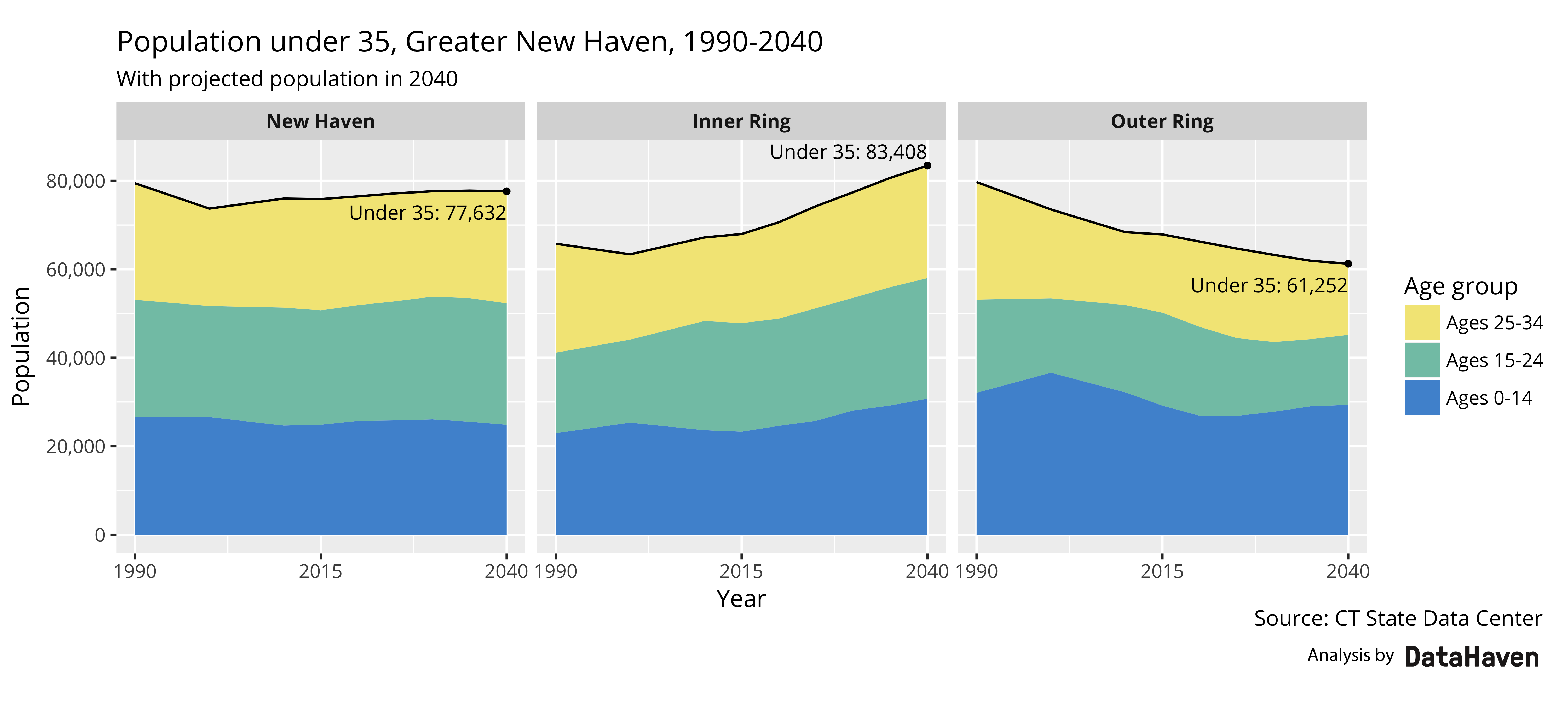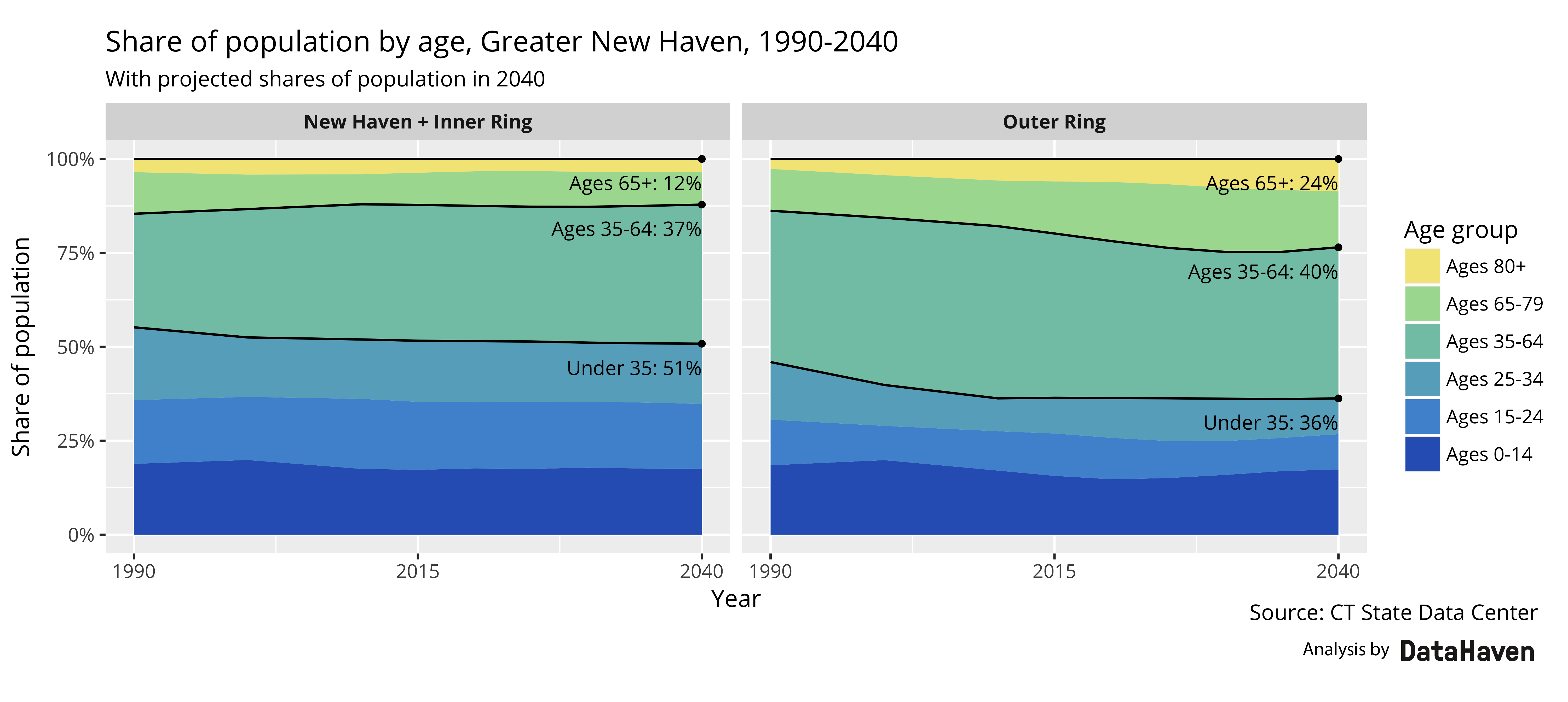Demographics, Housing
As State Ages, Havens For Young Will Grow
[Note: This article/op-ed was originally posted in the New Haven Independent on September 5, 2017. http://www.newhavenindependent.org/index.php/archives/entry/data_haven/]
by CAMILLE SEABERRY & MARK ABRAHAM
Updated population projections from the Connecticut State Data Center at UConn show a region with slowing growth, an aging population, and a movement toward the region’s core.
By 2040, more than 485,000 people are expected to live in the thirteen towns of the Greater New Haven region, about 20,000 more than live here today. The populations of the nine “outer ring” suburbs are becoming much older, and are projected to decline in size as people age in place but have fewer children at home. Meanwhile, the City of New Haven and parts of immediately adjacent towns have been growing, attracting a disproportionate share of younger adults, especially those with college degrees (the city has 3.6% of Connecticut’s population, but accounts for 53% of the entire statewide growth in young college graduates since 2000).
The Data Center’s population projections, which are funded by the Office of Policy and Management, are developed using birth and death records, migration data, and the Decennial Census. They are frequently used in publications such as the Greater New Haven Community Index to help describe potential demographic changes across Connecticut. However, local decisions may impact these future shifts – for example, towns that are projected to lose much of their working-age population may modify policies that currently restrict new housing. In a region where 75 percent of population growth over the past decade can be attributed to immigration, changes to federal policies may have an impact as well.
Havens For Young Workers
Other than New Haven, West Haven, and Hamden, every town in the region is projected to see a decline in its working age population by 2040, defined here as adults between the ages of 25 and 64.
In fact, West Haven and New Haven (visible in dark blue on our map below) are projected to add more working age adults than any other towns in Connecticut, with much of New Haven’s growth coming from an increase in the number of adults in their 30s and 40s.
Though it will remain smaller than the state’s major cities, these next few decades may be West Haven’s time to shine. West Haven’s working age population is set to grow by larger numbers than any other town in the entire state, with 9,000 new residents of working age; an increase of 30 percent. Changing age demographics need to be accompanied by changing infrastructure. Corresponding with the increase in younger adults, West Haven is projected to see growth in the number of children, who will need schools, childcare, youth programs, and parks; teenagers will need resources to support them moving into college and careers.
Though West Haven’s younger population is growing, young adults will remain concentrated in New Haven, and the city center will continue to be one of the few places in the Northeast to have a population that is majority under age 35. By 2040, more teenagers are projected to live in New Haven than the nine “outer ring” towns combined. This presents an opportunity to expand upon the city’s already vibrant youth arts and social justice communities and build up youth leadership and academics.
Aging Suburbs
On the flip side, Connecticut’s outer suburbs will need infrastructure to support their swelling population of older adults. By 2040, one quarter of the “outer ring” suburbs within Greater New Haven will be 65 or older, compared to only 12 percent in New Haven and the Inner Ring.
Compared to today, a much larger share of these older adults will be age 80 or older, raising many issues related to housing, transportation, social cohesion, and well-being. A recent study by DataHaven, commissioned by the World Health Organization, looked at ways to measure factors that impact the region’s age-inclusiveness.
Overall, the story of changing demographics in Greater New Haven mirrors that of other cities throughout the United States. New Haven, like other major city centers, is projected to grow (from about 130,000 to 144,000) and become even more important as a place where the region’s working-age adults are concentrated. Small cities like West Haven—towns with already diverse and growing populations — are projected to continue to grow and will need to adapt to meet the needs and opportunities of their young populations. Suburbs are becoming older, and their populations are projected to decline as older adults age in place and children leave.
As these older adults leave the workforce but remain in their homes, it will be even more important for the region to attract and retain younger workers and to ensure that they have the education and training needed to succeed in an economy that favors higher skill levels. Increasing the number of housing units built in city centers, or in other towns where policies allow, may help keep the housing market more affordable to younger workers as the total number of households continues to rise.
Camille Seaberry is Research Associate and Mark Abraham is Executive Director at DataHaven, a formal partner of the National Neighborhood Indicators Partnership with a 25-year history of public service to Connecticut. DataHaven’s mission is to improve quality of life by collecting, sharing and interpreting public data for effective decision making.




